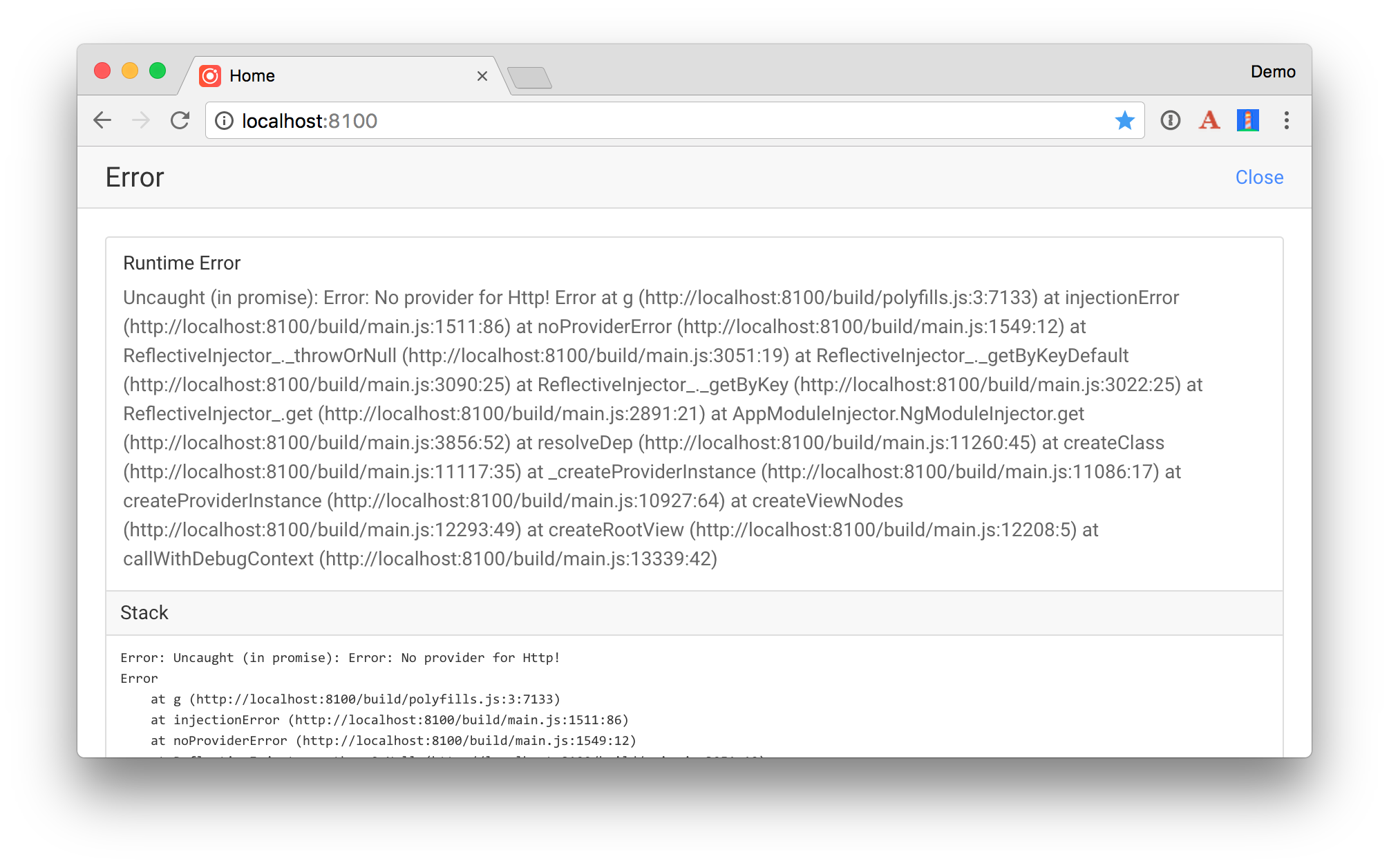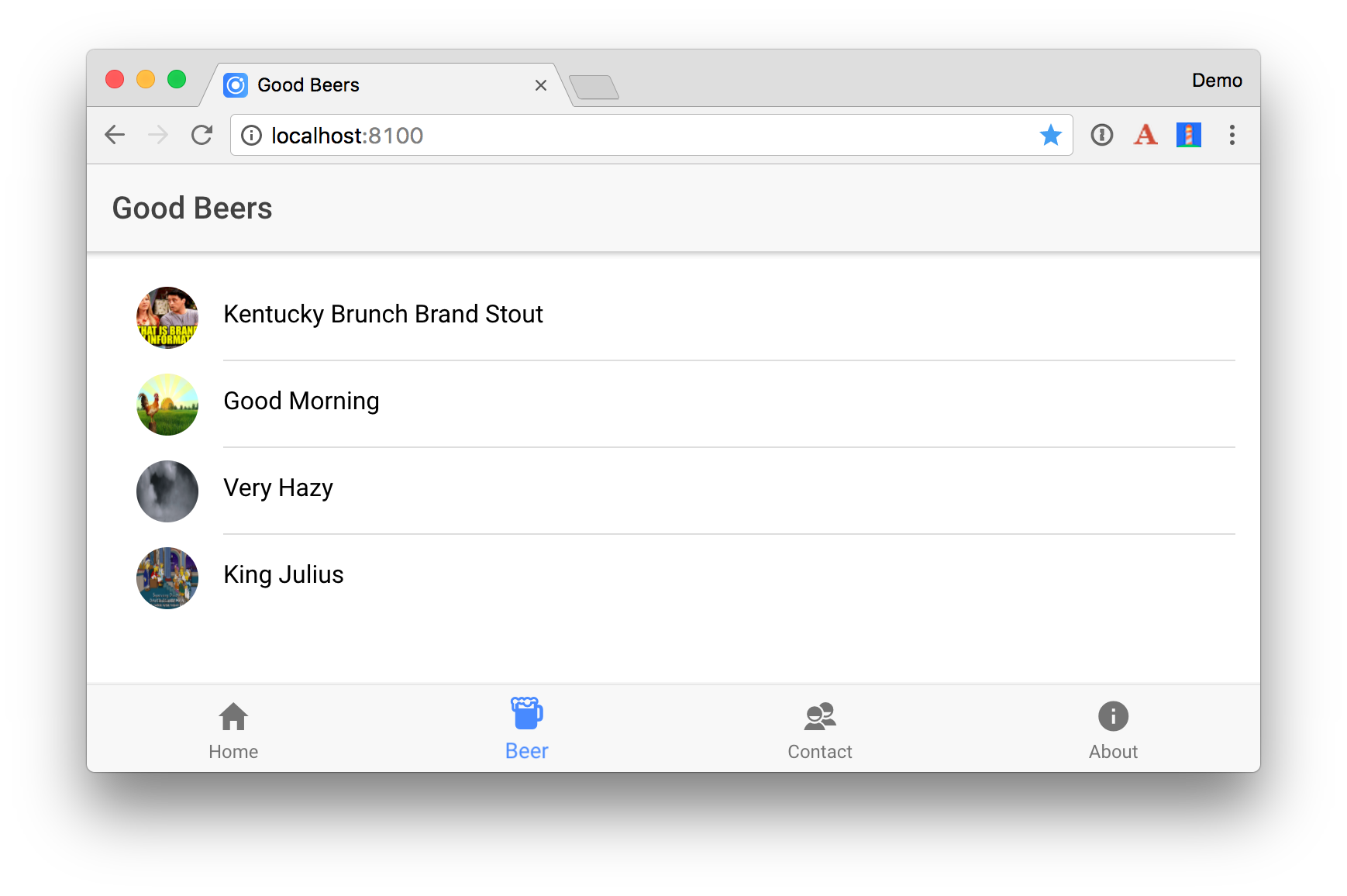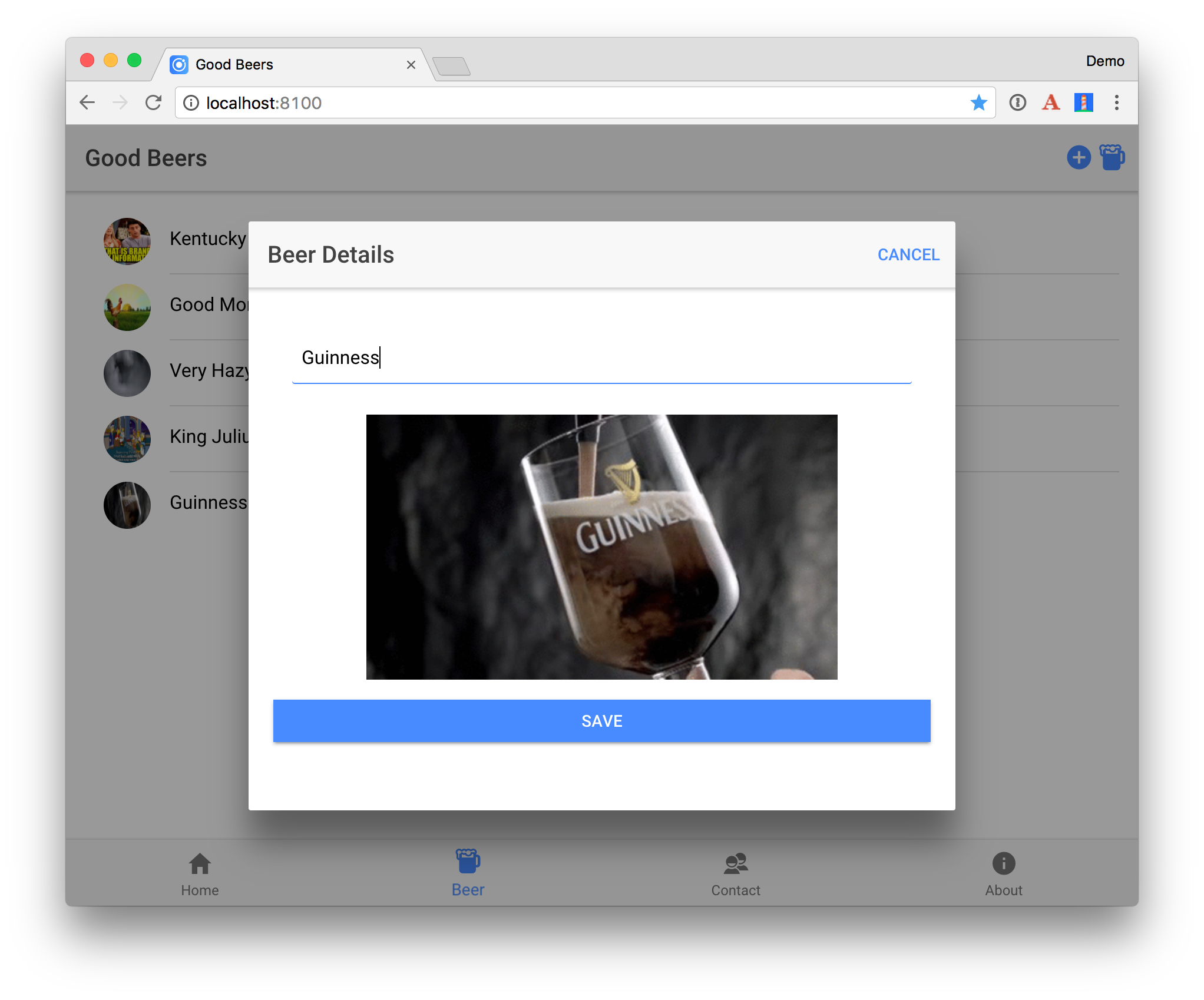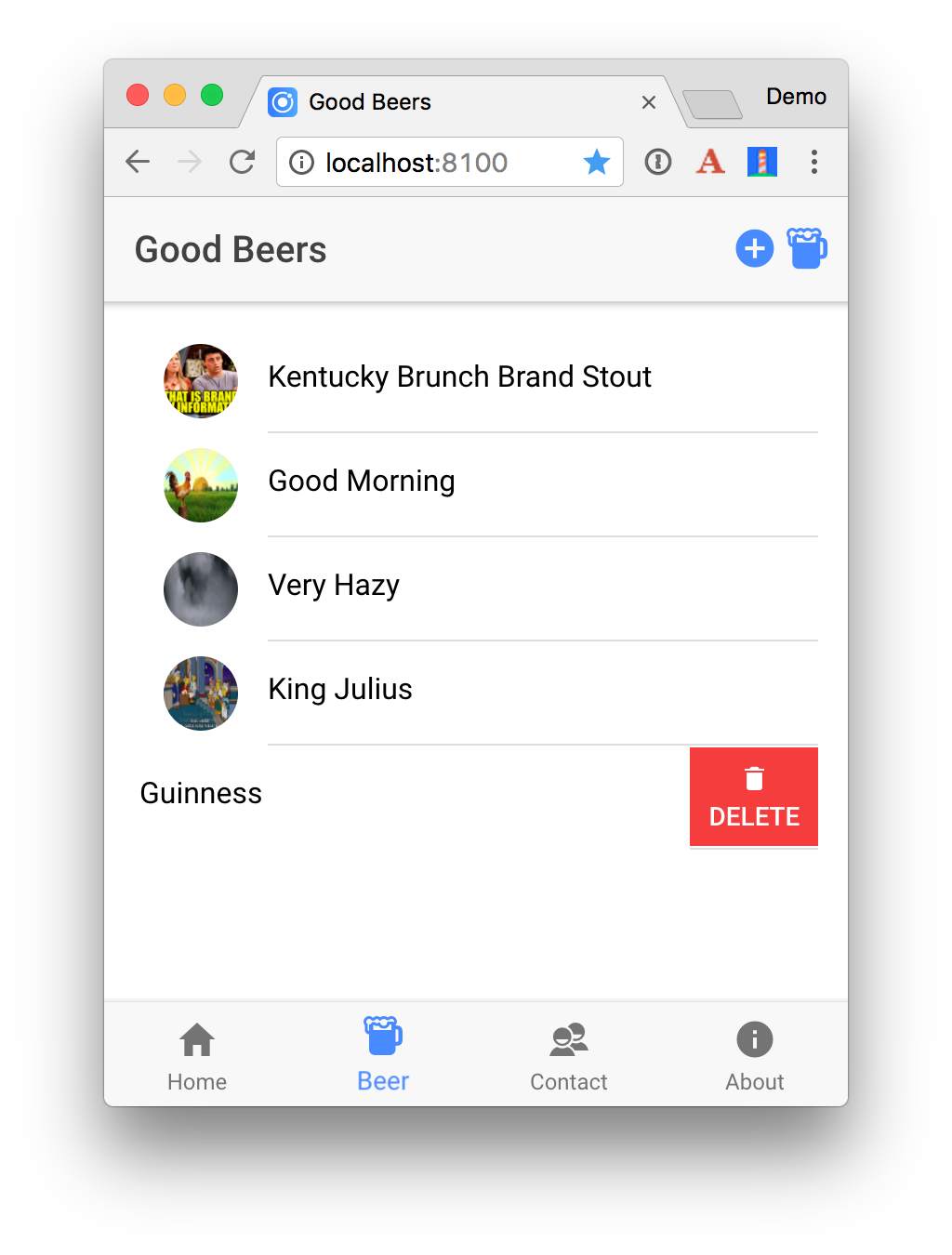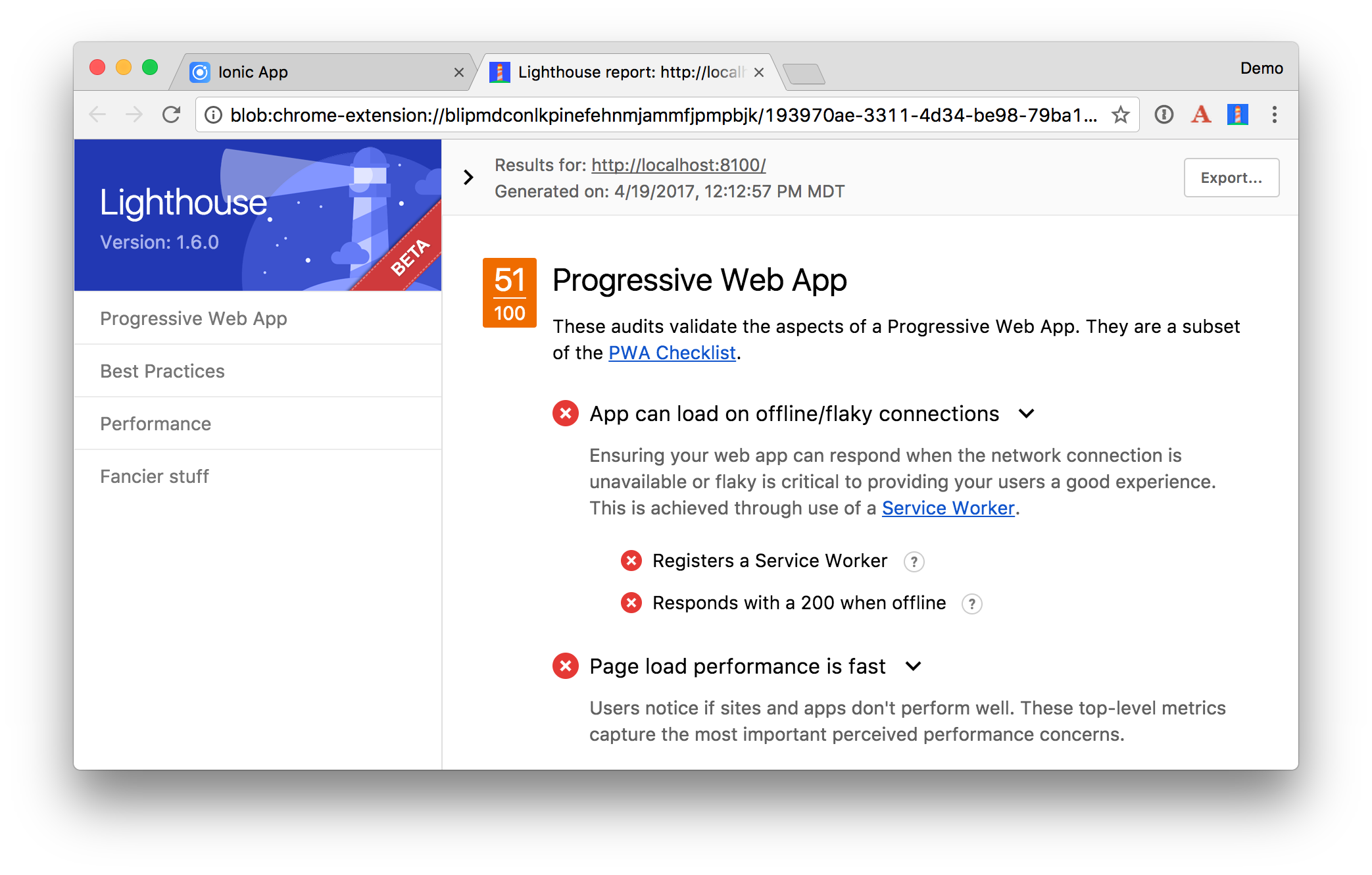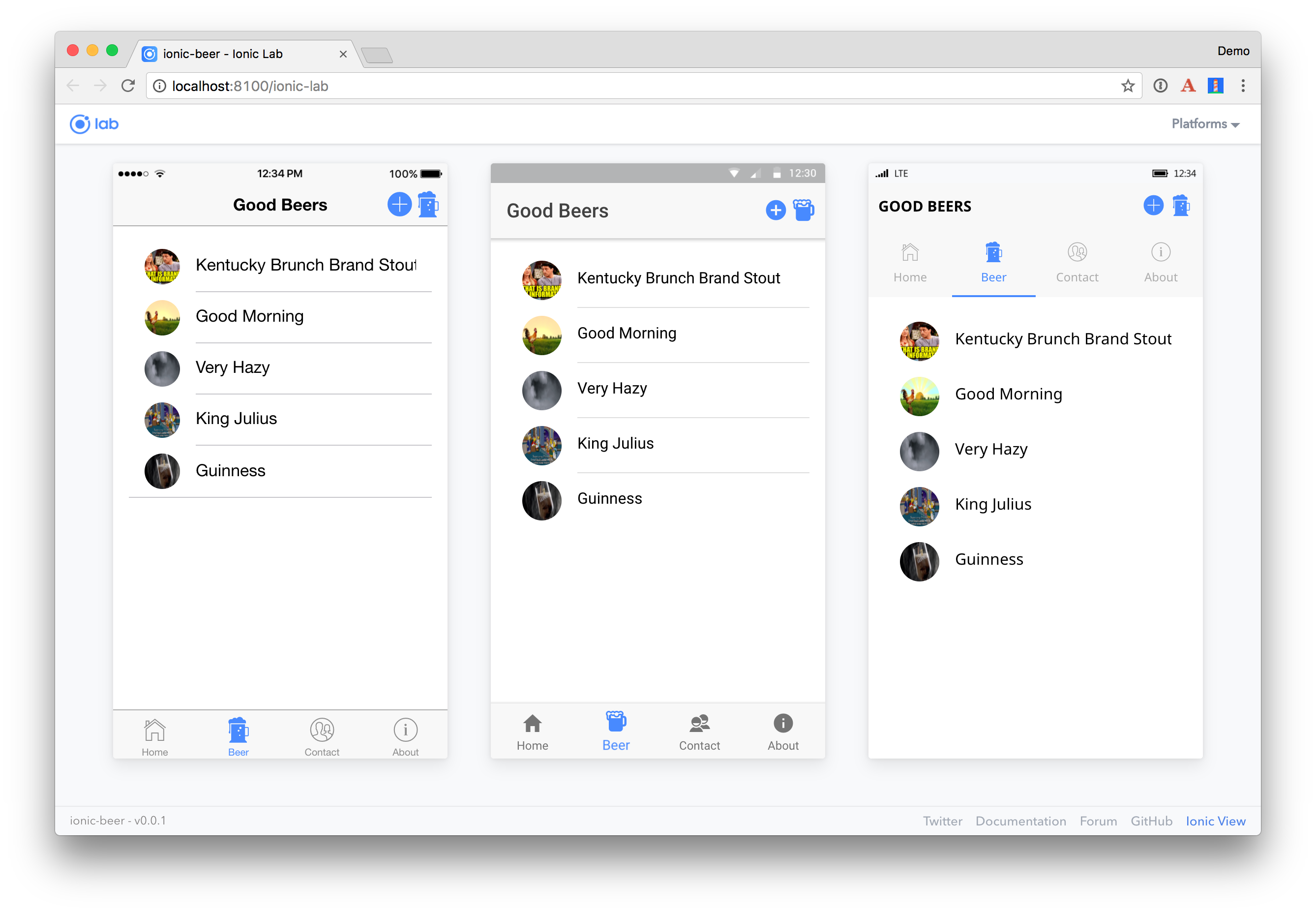TUTORIAL.md 29KB
Tutorial: Develop a Mobile App with Ionic and Spring Boot
Ionic 3.0 was recently released, with support for Angular 4, TypeScript 2.2, and lazy loading. Ionic, often called Ionic framework, is an open source (MIT-licensed) project that simplifies building native and progressive web apps. When developing an Ionic app, you'll use Angular and have access to native APIs via Ionic Native and Apache Cordova. This means you can develop slick-looking UIs using the technologies you know and love: HTML, CSS, and JavaScript/TypeScript.
This tutorial shows how to build a Spring Boot API, how to build an Ionic app, and how to deploy it to a mobile device.
Prerequisites: Java 8 and Node.js installed.
Create a Project
To begin, create a directory on your hard drive called spring-boot-ionic-example. During this tutorial, you will create server and ionic-beer directories to hold the server and client applications, respectively.
Spring Boot API
I recently wrote about how to build a Spring Boot API in a [QuickStart Guide to Spring Boot with Angular]. Rather than covering that again, you can clone the existing project and copy the server directory into spring-boot-ionic-example.
git clone https://github.com/oktadeveloper/spring-boot-angular-example.git
cp -r spring-boot-angular-example/server ~/spring-boot-ionic-example/.
This project contains a beers API that allows you to CRUD a list of beer names. It also contains a /good-beers endpoint that filters out less-than-great beers.
The default list of beers is created by a BeerCommandLineRunner class:
@Component
class BeerCommandLineRunner implements CommandLineRunner {
private final BeerRepository repository;
public BeerCommandLineRunner(BeerRepository repository) {
this.repository = repository;
}
@Override
public void run(String... strings) throws Exception {
// Top beers from https://www.beeradvocate.com/lists/top/
Stream.of("Kentucky Brunch Brand Stout", "Good Morning", "Very Hazy", "King Julius",
"Budweiser", "Coors Light", "PBR").forEach(name ->
repository.save(new Beer(name))
);
repository.findAll().forEach(System.out::println);
}
}
The BeerRepository interface is decorated with @RepositoryRestResource to expose CRUD endpoints for the Beer entity.
@RepositoryRestResource
interface BeerRepository extends JpaRepository<Beer, Long> {}
The last piece of the API is the BeerController that exposes /good-beers and specifies cross-origin resource sharing (CORS) settings.
@RestController
public class BeerController {
private BeerRepository repository;
public BeerController(BeerRepository repository) {
this.repository = repository;
}
@GetMapping("/good-beers")
@CrossOrigin(origins = "http://localhost:4200")
public Collection<Map<String, String>> goodBeers() {
return repository.findAll().stream()
.filter(this::isGreat)
.map(b -> {
Map<String, String> m = new HashMap<>();
m.put("id", b.getId().toString());
m.put("name", b.getName());
return m;
}).collect(Collectors.toList());
}
private boolean isGreat(Beer beer) {
return !beer.getName().equals("Budweiser") &&
!beer.getName().equals("Coors Light") &&
!beer.getName().equals("PBR");
}
}
You should be able to start the server application by running it in your favorite IDE or from the command line using mvn spring-boot:run. If you don't have Maven installed, you can use the Maven wrapper that's included in the project (./mvnw spring-boot:run on *nix, \mvnw spring-boot:run on Windows).
After the app has started, navigate to http://localhost:8080/good-beers. You should see the list of good beers in your browser.
Create Ionic App
To create an Ionic app to display data from your API, you'll first need to install Ionic CLI and Cordova:
npm install -g ionic cordova
The Ionic CLI is a command-line tool that greatly reduces the time it takes to develop an Ionic app. It's like a Swiss Army Knife: It brings together a bunch of miscellaneous tools under a single interface. The CLI contains a number of useful commands for Ionic development, such as start, build, generate, serve, and run.
After installation completes, create a new application using the following command:
ionic start ionic-beer --v2
This may take a minute or two to complete, depending on your internet connection speed. In the same terminal window, change to be in your application's directory and run it.
cd ionic-beer
ionic serve
This will open your default browser on http://localhost:8100. You can click through the tabbed interface to see the default structure of the app.
Create a Good Beers UI
Run ionic generate page beer to create a component and a template to display the list of good beers. This creates a number of files in src/app/pages/beer:
beer.html
beer.module.ts
beer.scss
beer.ts
Open beer.ts and change the name of the class to be BeerPage.
export class BeerPage {
constructor(public navCtrl: NavController, public navParams: NavParams) {
}
ionViewDidLoad() {
console.log('ionViewDidLoad BeerPage');
}
}
Modify beer.module.ts to change the class name too.
import { NgModule } from '@angular/core';
import { IonicModule } from 'ionic-angular';
import { BeerPage } from './beer';
@NgModule({
declarations: [
BeerPage
],
imports: [
IonicModule.forRoot(BeerPage),
],
exports: [
BeerPage
]
})
export class BeerModule {}
Add BeerModule to the imports list in app.module.ts.
import { BeerModule } from '../pages/beer/beer.module';
@NgModule({
...
imports: [
BrowserModule,
IonicModule.forRoot(MyApp),
BeerModule
],
...
})
Run ionic g provider beer-service to create a service to fetch the beer list from the Spring Boot API.
Change src/providers/beer-service.ts to have constants for the API path and add a getGoodBeers() method.
import { Injectable } from '@angular/core';
import { Http, Response } from '@angular/http';
import 'rxjs/add/operator/map';
import { Observable } from 'rxjs';
@Injectable()
export class BeerService {
public API = 'http://localhost:8080';
public BEER_API = this.API + '/beers';
constructor(private http: Http) {}
getGoodBeers(): Observable<any> {
return this.http.get(this.API + '/good-beers')
.map((response: Response) => response.json());
}
}
Modify beer.html to show the list of beers.
<ion-header>
<ion-navbar>
<ion-title>Good Beers</ion-title>
</ion-navbar>
</ion-header>
<ion-content padding>
<ion-list>
<ion-item *ngFor="let beer of beers">
<h2>{{beer.name}}</h2>
</ion-item>
</ion-list>
</ion-content>
Modify beer.module.ts to import BeerService and add it as a provider. You could add it as a provider in each component, but adding it in the module allows all components to use it.
import { BeerService } from '../../providers/beer-service';
@NgModule({
...
providers: [
BeerService
]
})
Update beer.ts to import BeerService and add it as a dependency in the constructor. Call the getGoodBeers() method in the ionViewDidLoad() lifecycle method.
import { Component } from '@angular/core';
import { IonicPage, NavController, NavParams } from 'ionic-angular';
import { BeerService } from '../../providers/beer-service';
@IonicPage()
@Component({
selector: 'page-beer',
templateUrl: 'beer.html'
})
export class BeerPage {
private beers: Array<any>;
constructor(public navCtrl: NavController, public navParams: NavParams,
public beerService: BeerService) {
}
ionViewDidLoad() {
this.beerService.getGoodBeers().subscribe(beers => {
this.beers = beers;
})
}
}
To expose this page on the tab bar, add it to tabs.ts
import { Component } from '@angular/core';
import { HomePage } from '../home/home';
import { AboutPage } from '../about/about';
import { ContactPage } from '../contact/contact';
import { BeerPage } from '../beer/beer';
@Component({
templateUrl: 'tabs.html'
})
export class TabsPage {
tab1Root: any = HomePage;
tab2Root: any = BeerPage;
tab3Root: any = ContactPage;
tab4Root: any = AboutPage;
constructor() {}
}
You'll also need to update tabs.html to have the new tab order.
<ion-tabs>
<ion-tab [root]="tab1Root" tabTitle="Home" tabIcon="home"></ion-tab>
<ion-tab [root]="tab2Root" tabTitle="Beer" tabIcon="beer"></ion-tab>
<ion-tab [root]="tab3Root" tabTitle="Contact" tabIcon="contacts"></ion-tab>
<ion-tab [root]="tab4Root" tabTitle="About" tabIcon="information-circle"></ion-tab>
</ion-tabs>
Add Some Fun with Animated GIFs
Run ionic g provider giphy-service to generate a GiphyService class. Replace the code in src/providers/giphy-service.ts with code that searches Giphy's API:
import { Injectable } from '@angular/core';
import { Http, Response } from '@angular/http';
import { Observable } from 'rxjs';
@Injectable()
// http://tutorials.pluralsight.com/front-end-javascript/getting-started-with-angular-2-by-building-a-giphy-search-application
export class GiphyService {
// Public beta key: https://github.com/Giphy/GiphyAPI#public-beta-key
giphyApi = 'https://api.giphy.com/v1/gifs/search?api_key=dc6zaTOxFJmzC&q=';
constructor(public http: Http) {
}
get(searchTerm): Observable<any> {
let apiLink = this.giphyApi + searchTerm;
return this.http.request(apiLink).map((res: Response) => {
let results = res.json().data;
if (results.length > 0) {
return results[0].images.original.url;
} else {
return 'https://media.giphy.com/media/YaOxRsmrv9IeA/giphy.gif'; // dancing cat for 404
}
});
}
}
Update beer.module.ts to import GiphyService and include it is as a provider.
import { GiphyService } from '../../providers/giphy-service';
@NgModule({
...
providers: [
BeerService,
GiphyService
]
})
Modify beer.ts to import GiphyService and set a giphyUrl on each beer.
import { Component } from '@angular/core';
import { IonicPage, NavController, NavParams } from 'ionic-angular';
import { BeerService } from '../../providers/beer-service';
import { GiphyService } from '../../providers/giphy-service';
@IonicPage()
@Component({
selector: 'page-beer',
templateUrl: 'beer.html'
})
export class BeerPage {
private beers: Array<any>;
constructor(public navCtrl: NavController, public navParams: NavParams,
public beerService: BeerService, public giphyService: GiphyService) {
}
ionViewDidLoad() {
this.beerService.getGoodBeers().subscribe(beers => {
this.beers = beers;
for (let beer of this.beers) {
this.giphyService.get(beer.name).subscribe(url => {
beer.giphyUrl = url
});
}
})
}
}
Update beer.html to display the image retrieved:
<ion-item *ngFor="let beer of beers">
<ion-avatar item-left>
<img src="{{beer.giphyUrl}}">
</ion-avatar>
<h2>{{beer.name}}</h2>
</ion-item>
Start the Spring Boot app in one terminal and run ionic serve in another. Open http://localhost:8100 in your browser. Click on the Beer icon and you'll likely see an error in your browser.
Uncaught (in promise): Error: No provider for Http!
This highlights one of the slick features of Ionic: errors are displayed in your browser, not just the browser's console. Add HttpModule to the list of imports in src/app/app.module.ts to solve this issue.
import { HttpModule } from '@angular/http';
@NgModule({
...
imports: [
BrowserModule,
HttpModule,
IonicModule.forRoot(MyApp),
BeerModule
],
After making this change, you'll likely see the following error in your browser's console.
XMLHttpRequest cannot load http://localhost:8080/good-beers. No 'Access-Control-Allow-Origin'
header is present on the requested resource. Origin 'http://localhost:8100' is therefore
not allowed access. The response had HTTP status code 401.
To fix this, open your Spring Boot application's BeerController.java class and change its @CrossOrigin annotation to allow http://localhost:8100 and file://. This enables cross-origin resource sharing (CORS) from both the browser and the mobile client.
@CrossOrigin(origins = {"http://localhost:8100","file://"})
public Collection<Map<String, String>> goodBeers() {
Recompile this class and DevTools should restart the application.
If everything works as expected, you should see a page similar to the one below in your browser.
Add a Modal for Editing
Change the header in beer.html to have a button that opens a modal to add a new beer.
<ion-header>
<ion-navbar>
<ion-title>Good Beers</ion-title>
<ion-buttons end>
<button ion-button icon-only (click)="openModal()" color="primary">
<ion-icon name="add-circle"></ion-icon>
<ion-icon name="beer"></ion-icon>
</button>
</ion-buttons>
</ion-navbar>
In this same file, change <ion-item> to have a click handler for opening the modal for the current item.
<ion-item *ngFor="let beer of beers" (click)="openModal({id: beer.id})">
Add ModalController as a dependency in BeerPage and add an openModal() method.
import { IonicPage, ModalController, NavController, NavParams } from 'ionic-angular';
export class BeerPage {
private beers: Array<any>;
constructor(public navCtrl: NavController, public navParams: NavParams,
public beerService: BeerService, public giphyService: GiphyService,
public modalCtrl: ModalController) {
}
// ionViewDidLoad()
openModal(beerId) {
let modal = this.modalCtrl.create(BeerModalPage, beerId);
modal.present();
// refresh data after modal dismissed
modal.onDidDismiss(() => this.ionViewDidLoad())
}
}
This won't compile because BeerModalPage doesn't exist. Create beer-modal.ts in the same directory. This page will retrieve the beer from the beerId that's passed in. It will render the name, allow it to be edited, and show the Giphy image found for the name.
import { BeerService } from '../../providers/beer-service';
import { Component, ViewChild } from '@angular/core';
import { GiphyService } from '../../providers/giphy-service';
import { NavParams, ViewController, ToastController, NavController } from 'ionic-angular';
import { NgForm } from '@angular/forms';
@Component({
templateUrl: './beer-modal.html'
})
export class BeerModalPage {
@ViewChild('name') name;
beer: any = {};
error: any;
constructor(public beerService: BeerService,
public giphyService: GiphyService,
public params: NavParams,
public viewCtrl: ViewController,
public toastCtrl: ToastController,
public navCtrl: NavController) {
if (this.params.data.id) {
this.beerService.get(this.params.get('id')).subscribe(beer => {
this.beer = beer;
this.beer.href = beer._links.self.href;
this.giphyService.get(beer.name).subscribe(url => beer.giphyUrl = url);
});
}
}
dismiss() {
this.viewCtrl.dismiss();
}
save(form: NgForm) {
let update: boolean = form['href'];
this.beerService.save(form).subscribe(result => {
let toast = this.toastCtrl.create({
message: 'Beer "' + form.name + '" ' + ((update) ? 'updated' : 'added') + '.',
duration: 2000
});
toast.present();
this.dismiss();
}, error => this.error = error)
}
ionViewDidLoad() {
setTimeout(() => {
this.name.setFocus();
},150);
}
}
Add the import for BeerModalPage to beer.ts, then create beer-modal.html as a template for this page.
<ion-header>
<ion-toolbar>
<ion-title>
{{beer ? 'Beer Details' : 'Add Beer'}}
</ion-title>
<ion-buttons start>
<button ion-button (click)="dismiss()">
<span ion-text color="primary" showWhen="ios,core">Cancel</span>
<ion-icon name="md-close" showWhen="android,windows"></ion-icon>
</button>
</ion-buttons>
</ion-toolbar>
</ion-header>
<ion-content padding>
<form #beerForm="ngForm" (ngSubmit)="save(beerForm.value)">
<input type="hidden" name="href" [(ngModel)]="beer.href">
<ion-row>
<ion-col>
<ion-list inset>
<ion-item>
<ion-input placeholder="Beer Name" name="name" type="text"
required [(ngModel)]="beer.name" #name></ion-input>
</ion-item>
</ion-list>
</ion-col>
</ion-row>
<ion-row>
<ion-col *ngIf="beer" text-center>
<img src="{{beer.giphyUrl}}">
</ion-col>
</ion-row>
<ion-row>
<ion-col>
<div *ngIf="error" class="alert alert-danger">{{error}}</div>
<button ion-button color="primary" full type="submit"
[disabled]="!beerForm.form.valid">Save</button>
</ion-col>
</ion-row>
</form>
</ion-content>
Add BeerModalPage to the declarations and entryComponent lists in beer.module.ts.
You'll also need to modify beer-service.ts to have get() and save() methods.
get(id: string) {
return this.http.get(this.BEER_API + '/' + id)
.map((response: Response) => response.json());
}
save(beer: any): Observable<any> {
let result: Observable<Response>;
if (beer['href']) {
result = this.http.put(beer.href, beer);
} else {
result = this.http.post(this.BEER_API, beer)
}
return result.map((response: Response) => response.json())
.catch(error => Observable.throw(error));
}
At this point, if you try to add or edit a beer name, you'll likely see an error in your browser's console.
ModalCmp ionViewPreLoad error: No component factory found for BeerModalPage.
Did you add it to @NgModule.entryComponents?
Add BeerModalPage to the list of entryComponents in app.module.ts. While you're in there, add BeerService to the list of global providers so you don't have to add it to each component that uses it.
@NgModule({
...
entryComponents: [
...
BeerModalPage
],
providers: [
BeerService,
...
]
})
Now if you try to edit a beer's name, you'll see another CORS in your browser's console. Add a @CrossOrigin annotation to BeerRepository.java (in your Spring Boot project) that matches the one in BeerController.
@RepositoryRestResource
@CrossOrigin(origins = {"http://localhost:8100","file://"})
Re-compile and now everything should work as expected. For example, below is a screenshot that shows I added a new beer and what it looks like when editing it.
Add Swipe to Delete
To add swipe-to-delete functionality on the list of beers, open beer.html and make it so <ion-item-sliding> wraps <ion-item> and contains the *ngFor. Add a delete button using <ion-item-options>.
<ion-content padding>
<ion-list>
<ion-item-sliding *ngFor="let beer of beers">
<ion-item (click)="openModal({id: beer.id})">
<ion-avatar item-left>
<img src="{{beer.giphyUrl}}">
</ion-avatar>
<h2>{{beer.name}}</h2>
</ion-item>
<ion-item-options>
<button ion-button color="danger" (click)="remove(beer)"><ion-icon name="trash"></ion-icon> Delete</button>
</ion-item-options>
</ion-item-sliding>
</ion-list>
</ion-content>
Add a remove() method to beer.ts.
remove(beer) {
this.beerService.remove(beer.id).subscribe(response => {
for (let i = 0; i < this.beers.length; i++) {
if (this.beers[i] === beer) {
this.beers.splice(i, 1);
let toast = this.toastCtrl.create({
message: 'Beer "' + beer.name + '" deleted.',
duration: 2000,
position: 'top'
});
toast.present();
}
}
});
}
Add toastCtrl as a dependency in the constructor so everything compiles.
constructor(public navCtrl: NavController, public navParams: NavParams,
public beerService: BeerService, public giphyService: GiphyService,
public modalCtrl: ModalController, public toastCtrl: ToastController) {
}
You'll also need to modify beer-service.ts to have a remove() method.
remove(id: string) {
return this.http.delete(this.BEER_API + '/' + id)
.map((response: Response) => response.json());
}
After making these additions, you should be able to delete beer names. To emulate a left swipe in your browser, click on the item and drag it to the left.
PWAs with Ionic
Ionic ships with support for creating progressive web apps (PWAs). If you'd like to learn more about what PWAs are, see Navigating the World of Progressive Web Apps with Ionic 2. This blog post is still relevant for Ionic 3.
If you run the Lighthouse Chrome extension on this application, you'll get a mediocre score (51/100).
To register a service worker, and improve the app's score, uncomment the following block in src/index.html.
<!-- un-comment this code to enable service worker
<script>
if ('serviceWorker' in navigator) {
navigator.serviceWorker.register('service-worker.js')
.then(() => console.log('service worker installed'))
.catch(err => console.log('Error', err));
}
</script>-->
After making this change, the score should improve. In my tests, it increased to 66/100. The remaining issues were:
- A couple -1's in performance for "Cannot read property 'ts' of undefined".
- Site is not progressively enhanced (page should contain some content when JavaScript is not available). This could likely be solved with Angular's app-shell directives.
- Site is not on HTTPS and does not redirect HTTP to HTTPS.
If you refresh the app and Chrome doesn't prompt you to install the app (a PWA feature), you probably need to turn on a couple of features. Copy and paste the following URLs into Chrome and enable each feature.
chrome://flags/#bypass-app-banner-engagement-checks
chrome://flags/#enable-add-to-shelf
After enabling these flags, you'll see an error in your browser's console about assets/imgs/logo.png not being found. This file is referenced in src/manifest.json. You can fix this by copying a 512x512 PNG (like this one) into this location or by modifying manifest.json accordingly. At the very least, you should modify manifest.json to have your app's name.
Deploy to a Mobile Device
It's pretty cool that you're able to develop mobile apps with Ionic in your browser. However, it's nice to see the fruits of your labor and see how awesome your app looks on a phone. It really does look and behave like a native app!
To see how your application will look on different devices you can run ionic serve --lab. The --lab flag opens opens a page in your browser that lets you see how your app looks on different devices.
iOS
To emulate or deploy to an iOS device, you'll need a Mac and a fresh installation of Xcode. If you'd like to build iOS apps on Windows, Ionic offers an Ionic Package service.
Make sure to open Xcode to complete the installation.
Ionic 3.0 generates iOS-enabled applications by default. If you're using a version that didn't generate a platforms/ios directory, add support for it using the following command.
ionic platform add ios
Then run ionic emulate ios to open your app in Simulator.
TIP: The biggest problem I found when running the app in Simulator was that it was difficult to get the keyboard to popup. To workaround this, I used Hardware > Keyboard > Toggle Software Keyboard when I needed to type text in a field.
Deploying to your phone will likely fail because it won't be able to connect to http://localhost:8080. To fix this, you can deploy your Spring Boot app to a public server, or use your computer's IP address in beer.service.ts (if you're on the same network).
To deploy to Cloud Foundry, copy this deploy script to your hard drive. It expects to be in a directory above your apps (e.g. spring-boot-ionic-example). It also expects your apps to be named ionic-beer and server.
If you don't have a Cloud Foundry account, you'll need to create one. Then install its command line tools for this script to work.
brew tap cloudfoundry/tap && brew install cf-cli
To deploy the app to an iPhone, start by plugging it into your computer. Then run the following commands to install ios-deploy/ios-sim, build the app, and run it on your device.
npm install -g ios-deploy ios-sim
ionic build ios --prod
cd platforms/ios/
open ionic-beer.xcodeproj
Select your phone as the target in Xcode and click the play button to run your app. The first time you do this, Xcode may spin for a while with a "Processing symbol files" message at the top.
NOTE: If you run into code signing issues, see Ionic's deployment documentation to see how to solve.
Once you've configured your phone, computer, and Apple ID to work, you should be able to open the app and see the beer list you created. Below is how it looks on my iPhone 6s Plus.

Android
To emulate or deploy to an Android device, you'll first need to install Android Studio. As part of the install, it will show you where it installed the Android SDK. Set this path as an ANDROID_HOME environment variable. On a Mac, it should be ~/Library/Android/sdk/.
If you've just installed Android Studio, make sure to open it to complete the installation.
To deploy to the Android emulator, add support for it to the ionic-beer project using the ionic command.
ionic platform add android
If you run ionic emulate android you'll get instructions from about how to create an emulator image.
Error: No emulator images (avds) found.
1. Download desired System Image by running: /Users/mraible/Library/Android/sdk/tools/android sdk
2. Create an AVD by running: /Users/mraible/Library/Android/sdk/tools/android avd
HINT: For a faster emulator, use an Intel System Image and install the HAXM device driver
Run the first suggestion and download your desired system image. Then run the second command and created an AVD (Android Virtual Device) with the following settings:
AVD Name: TestPhone
Device: Nexus 5
Target: Android 7.1.1
CPU/ABI: Google APIs Intel Axom (x86_64)
Skin: Skin with dynamic hardware controls
After performing these steps, you should be able to run ionic emulate android and see your app running in the AVD.

NOTE: If you get an application error that says "The connection to the server was unsuccessful. (file:///android/www/index.html)", add the following line to config.xml. This sets the default timeout to 60 seconds (default is 20). Thanks to Stack Overflow for the answer.
<preference name="loadUrlTimeoutValue" value="60000"/>
Learn More
I hope you've enjoyed this tour of Ionic and Angular. I like how Ionic takes your web development skills up a notch and allows you to create mobile applications that look and behave natively.
You can find a completed version of the application created in this blog post on GitHub.
If you encountered issues, please create an issue in GitHub or hit me up on Twitter @mraible.
To learn more about Ionic or Angular, please see the following resources:
- Get started with Ionic Framework
- Angular + Spring Boot
- Angular Authentication with OpenID Connect and Okta in 20 Minutes
- Getting Started with Angular A YouTube webinar by yours truly. ;)



